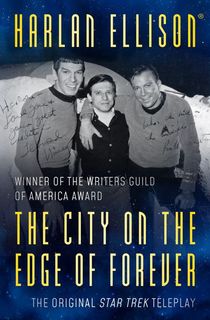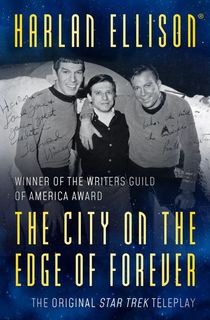“The City on the Edge of Forever” is widely considered one of the best Star Trek episodes of all time, as declared by TV Guide, Entertainment Weekly, and countless devoted Trekkies. It managed to capture hearts and minds by doing what Star Trek did best: engaging in high-stakes moral quandaries of the day within an intergalactic context. However, the beloved episode is nearly as well known for stirring controversy as it is for its devoted fanbase.
RELATED: 8 Times Star Trek Accurately Predicted Future Technology
“The City on the Edge of Forever” features a time portal, through which Kirk and Spock enter to find themselves in Depression-era New York City. They must resist the urge to change the course of history, but that goal is complicated by Kirk falling in love with a woman who must die in order to ensure an Allied victory in World War II. This is the story we’re told, but it’s a far cry from what acclaimed speculative fiction author Harlan Ellison envisioned when he wrote the original script in 1966.
In what became a famous dispute between Ellison and Star Trek creator Gene Roddenberry, Ellison publicly condemned the extensive rewriting of his script. Roddenberry insisted the rewrites were necessary to come in under budget, but Ellison wasn’t one to let things go. When the episode was granted the 1968 Hugo Award for Best Dramatic Presentation, Ellison dedicated his acceptance speech to “the memory of the script they butchered, and in respect to those parts of it that had the vitality to shine through the evisceration.” Twenty years later, Ellison channeled his lingering frustrations into a 1988 essay that explained his version of events and how his brainchild developed into the episode we know and love today.
RELATED: A Tale of Two Wastelands: Fallout and Harlan Ellison's "A Boy and His Dog"
An updated version of that essay appears in his book The City on the Edge of Forever. Read on to discover Ellison’s irate and feisty personality in the following excerpt from the introduction of The City on the Edge of Forever. Then, download the ebook to read Ellison’s award-winning teleplay in its original form and learn about the behind-the-scenes development of one of the best Star Trek episodes of all time.
Read the excerpt below, then download a copy!
But, astonishingly, thereafter, every single letter or phone call or InterNet message passed along to me (I have no computer or modem or interest in wasting my life on these electronic yenta boards) congratulated me for having the (what one reader called) “ethical muscle” to tell it “like it was.” Well, gee whillikers, folks, how swell that you thought I was an icon of rectitude and justified moral indignation. I just have one question to ask:
Where the fuck were you for thirty years while Roddenberry and his running-dogs dissed me and smeared my rep?
RELATED: 8 Brutally Honest Harlan Ellison Quotes
But, then, I shouldn’t be rude to you. After all, didn’t you pay good money to buy my book? So let me just get on with it, and reprint my article from TV Guide. And when I return, New Horrors! New Horrors!
Last fall, Entertainment Weekly did one of these special Star Trek issues and they ranked all 79 episodes of the original series. Number one, all-time best, most popular episode was “The City on the Edge of Forever.” Undisputedly the best episode of Star Trek.

Joan Collins as Edith Keeler and William Shatner as Captain Kirk in "The City on the Edge of Forever"
Photo Credit: Desilu ProductionsI wrote that episode. The words didn’t spring unbidden from Spock and Kirk’s mouths, they were written. By me. The tragic love story in which the principal protagonists of the Enterprise went back in time to New York City during the Great Depression of 1930, and Kirk watched as the woman he loved—Sister Edith Keeler—was killed … I spent most of 1966 writing and rewriting and re-rewriting. I watched it once, only once—when it originally aired over NBC on April 6, 1967—and have been unable to bring myself to look at it again since that evening. One would think the anger and the punch in the heart would abate after more than thirty years. But Star Trek has become as anally retentive a cult as the most obsessive True Believer could wish, and the urban myths that have been cobbled up about “City,” and my script, march on tirelessly. They are horse puckey, but on they trudge.
In the film The Man Who Shot Liberty Valance, there is a line that has become famous. It is this: “When the legend becomes fact, print the legend.”
That is to say, why bother with the truth when horse puckey allows the True Believers to enjoy their obsession in a state of blissful ignorance?
I cannot tell you the truth. You would not want it, or believe it, or honor me in any way for having told it to you. Crybabies whine for the truth.
What you want is myth and half-truth. Okay, I can do that. But what follows is only that part of the truth that will not curdle your milk. The snail on the rose remains hidden.
Want to keep reading? Download The City on the Edge of Forever today!
This post is sponsored by Open Road Media. Thank you for supporting our partners, who make it possible for The Portalist to continue publishing the stories you love.
Featured still from "Star Trek: The Original Series" via Desilu Productions


